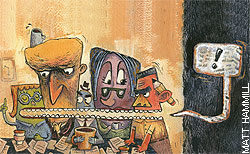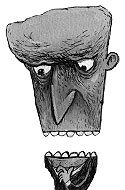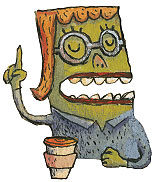A Matter of Opinion
Why editorial boards are more relevant than ever—sort of
 The October 28, 2005 headline jumps off the Chronicle Herald‘s front page: “ATV Crash Kills Two Girls.” The girls, aged 14 and 15, died just outside Shubenacadie, near Halifax, when the all-terrain vehicle they were riding went down a four-metre embankment and crashed into a mass of trees. The 14-year-old driver, another girl, was injured in the accident. Nova Scotians had already been anguishing over the laws, or lack thereof, restricting underage use of ATVs. Pediatricians had been pleading the case that mishaps of this kind were preventable if only the provincial government would pass a law limiting underage ATV use. But few thought the need was that serious – until now.
The October 28, 2005 headline jumps off the Chronicle Herald‘s front page: “ATV Crash Kills Two Girls.” The girls, aged 14 and 15, died just outside Shubenacadie, near Halifax, when the all-terrain vehicle they were riding went down a four-metre embankment and crashed into a mass of trees. The 14-year-old driver, another girl, was injured in the accident. Nova Scotians had already been anguishing over the laws, or lack thereof, restricting underage use of ATVs. Pediatricians had been pleading the case that mishaps of this kind were preventable if only the provincial government would pass a law limiting underage ATV use. But few thought the need was that serious – until now.
The Chronicle Herald‘s editorial board usually begins its daily ritual just past 9 A.M. Editor-in-chief Bob Howse and editorial writers Laurent Le Pierres, Don MacDonald and Paul Schneidereit each bring four to seven ideas to the table. After some dickering and debate, they settle on the next day’s two editorial topics and split from the meeting. They base an idea’s eligibility on a number of criteria: Will it engage readers of the most widely read daily in Nova Scotia? Is it important to them? Is it an important issue regionally? Will they benefit from the newspaper’s perspective? But some days – like today – a hot topic renders the decision a no-brainer.
The editorial meeting moves quickly. Everyone operates on the same wavelength. There is little dissent.
“Oh my God, when I saw this picture…” Le Pierres looks mildly shocked as he holds up his copy of the paper.
“I know,” replies Howse. “We’re going to have put the other stuff away for now.”
Heads nod in agreement.
“It’ll probably go on the front page,” Howse continues, thinking aloud. “Yeah, it’ll go on the front.”
“It’ll have to be sensitive, though,” warns Schneidereit.
“Reinforce what the pediatricians have been saying all along,” argues Howse. “Something’s gotta be done now.”
“It’s going to have to swing the vote,” says Schneidereit.
“I’ll write this one,” says Howse.
On the front page, Howse’s October 29, 2005 editorial calls for the government to pass a law restricting ATV use immediately. “This is a terrible day, the worst day, we know, to argue child-safety legislation for ATVs,” it reads. Further down it says, “So who will put the kids’ interests first? Who is going to stick a neck out and set the right example of making child-safety decisions on the best evidence? Mr. Premier, it has to be you.” On Thursday, December 8, 2005, a law banning children under the age of 14 from riding ATVs, except on closed courses, passed in the Nova Scotia legislature by a free vote of thirty to fifteen. It was not a total victory since the driver in the tragedy had been 14, but bundled in came other, stricter provisions. Parents must supervise ATV activities for children under 14 and a person with training in firstaid procedures must be present.
Arguably, the Chronicle Herald – with its Monday-to-Saturday circulation of 114,000 – influenced the outcome of the vote. The editorial board would like to think so, although Le Pierres says the paper generally doesn’t try to sway reader opinion. “Most people know the news by the time they get the paper. We do the post-game show,” he says. “We call it the way we see it, and sometimes that’s unpopular.” 
Unpopular or not, editorials are designed to sort through issues with informed arguments and help readers develop and revise their opinions. According to a study conducted by the Newspaper Audience Databank Inc. (NADbank) in 2004, thirty-eight per cent of Canadians read newspaper editorials “usually” and twenty-nine per cent “sometimes.” The research also showed that editorials draw in more regular readers than the sports section, which only thirty-six per cent read “usually” and eighteen per cent “sometimes.”
The statistics look promising, yet not everyone is convinced we’re in the heyday of the well-crafted editorial. More likely, it’s the era of the instant opinion – with a few clicks of the mouse, readers can now find countless diverse views. Editors, of course, stand firm in the belief that editorial boards still serve a purpose, but the answer isn’t quite so emphatic among those who have no stake in editorial writing. National and regional newspapers both aim to educate readers with editorials. But while many people dismiss national editorials as having little swaying power, regional editorials often advocate for one side or another when it comes to local issues. And they can be influential as long as readers don’t sense the board is hostage to one political ideology.
Editorials have long embraced two main purposes, according to Howse. First and foremost, he says, there’s the local angle, which focuses on the paper’s community “in terms of advocating better public services, a fairer legal system, a new school or hospital.” The other raison d’?tre is to use argument and opinion to debate politics, endorse a party or let readers know how political issues are affecting them. But the editorial has evolved a great deal since it began. Newspapers started to gain popularity around the late 18th and early 19th centuries in North America at a time when political parties were becoming prominent. Rarely was raw opinion separate from hard news – neither writers nor readers bothered to make much of a distinction between opinion and fact. “It’s not surprising that political parties and partisans were often involved in establishing newspapers that would promote their views and support them editorially,” says Howse. Most newspaper owners made no effort to hide the fact that they were tied specifically to one political stream of thought.
 As the opinions often came from one person, most editorials were signed, and, more often than not, people knew the writer. But around the time of the Civil War in the United States, corporations started investing in and buying up newspapers, according to Kenneth Rystrom, author of several books on newspaper editorials. Gradually, groups of editors within newspapers began to argue an array of opinions and come to a consensus, rather than having one person represent the paper. Editorial boards were created with the goal of formulating views that stood for the entire paper. The signed editorial all but disappeared (except, notably, in Quebec).
As the opinions often came from one person, most editorials were signed, and, more often than not, people knew the writer. But around the time of the Civil War in the United States, corporations started investing in and buying up newspapers, according to Kenneth Rystrom, author of several books on newspaper editorials. Gradually, groups of editors within newspapers began to argue an array of opinions and come to a consensus, rather than having one person represent the paper. Editorial boards were created with the goal of formulating views that stood for the entire paper. The signed editorial all but disappeared (except, notably, in Quebec).
In the latter half of the 20th century, the introduction of communications technology like television and the Internet played a huge role in the evolution of the editorial. Today, the reader may be at least as educated about the issues as the editorial writers. Also, over the last century, many newspapers lost their strong partisan ties. For example, the Chronicle was always Nova Scotia’s Liberal paper, while The Herald remained steadfastly Conservative. These political positions were maintained until the late 1940s, when the papers merged and became the independent, non-partisan Chronicle- Herald, the predecessor to today’s Chronicle Herald. For the combined paper, keeping up with changing preferences meant using sound editorial and business judgement and accepting the fact that readers wanted a broader range of opinion and generally held more educated views. Understanding and catering to the needs of their diverse audiences is something editorial boards at regional newspapers in Canada must cultivate assiduously.
At 8:30 A.M. on most weekdays, Howse can be found busily scanning the sheets of newspaper that cover every available inch of his desk. As the Chronicle Herald‘s editor-inchief and editorial page editor, Howse hunts for topics to write about. Glancing over headlines, primarily his own paper’s, he also checks the ones on offer at the two national dailies, The Globe and Mail and the National Post. He picks up his office telephone and presses several numbers. “So how about your office today, Laurent? … Okay, we’ll be up in a few minutes.” Click.
Armed with ideas, Howse walks across the hall to owner and publisher Graham William Dennis’s office. Dennis, who has run the company since 1954, likes to keep tabs on the menu of issues. “He spends a lot of time travelling around the province and meeting people,” says Howse. “His contribution is to see that every part of the province is covered.” Howse then makes his way to Le Pierres’s office – the exact location of the meeting changes from day to day – where framed broadsheets adorn the walls. Alongside them hangs a sheet of George W. Bush photos printed on computer paper. Beside each small photo of the U.S. president is a corresponding picture of a similar-looking monkey – a joke implying the two had been separated at birth. “Is this going to make it into your article?” Le Pierres asks, laughing. Another editorial board member, Don MacDonald, distributes a round of Tim Hortons coffee, and away they go.
Generally, this is the way editorial board meetings begin, but today, on yet another cool and windy late October morning, I’ve pulled a pre-emptive strike. Howse is sitting across from me in his office. Schneidereit, another board member, the one who moonlights as president of the Canadian Association of Journalists, is to my left. A notebook filled with scribbled editorial ideas sits open across his lap. I’m wondering what ideas they’ve come up with for tomorrow’s editorial section. Progress in Iraq, Premier John Hamm’s plan to combat drinking and driving and Roche Canada’s decision to hold off on the distribution of Tamiflu have all been subjects of editorials this week.
“Well, there’s that thing about the Bluenose,” Schneidereit says. He’d mentioned it earlier in the week, but other topics took precedence. Turning toward me in his swivel seat, he proceeds to discuss the Bluenose bickering that I’ve missed since moving to Toronto. “The Bluenose Preservation Foundation was trying to control the use of the Bluenose image,” he says, a faint smile tugging at the corners of his mouth. Now, the Lunenburg Marine Museum Society, a Nova Scotia organization, operates the Bluenose II and the Fisheries Museum of the Atlantic. There have been ongoing disputes over who should get control of all monies concerning the Bluenose between the government, the Bluenose II Preservation Trust and the society running the fisheries museum.
“That sounds ridiculous,” I say. I try to think of every time I’ve come across the famed Bluenose image – it’s everywhere in Nova Scotia.
“Well I know, that’s the thing,” Schneidereit says, shaking his head. “It’s like trying to trademark an image of the Eiffel Tower.” Howse listens, sometimes nodding in agreement. It looks like they’ll be doing something on another regional issue dear to readers. “Okay,” he says. “Why don’t you work on that for today?” The result, an October 28, 2005 editorial entitled “Stop Playing Bluenose Games” calls for those involved in the Bluenose squabbles to put the “reputation of Nova Scotia’s famed sailing ambassador first” and settle their differences.
The Bluenose controversy may elicit an incredulous response from some, but the editorial board has to keep its antennae finely tuned to all regional concerns – no matter how absurd. It’s actually a matter of survival. TheChronicle Herald, along with just a few others like the Whitehorse Star and Montreal’s Le Devoir, is one of the country’s last remaining independently owned dailies – and the editors like it that way. “There’s something to be said that it isn’t beholden to a larger corporation,” Le Pierres says.
The Chronicle Herald has been in the Dennis family since 1875, and Dennis says he intends to keep it independent. It’s this independence that allows the board to serve the community best. “The best owners are the ones who don’t interfere,” says Le Pierres. “They know how to delegate, and they know that they can’t possibly be the universal view.” Board members credit their publisher’s passion for the newspaper as part of the Herald‘s success. “Dennis’s motivation,” says Howse, “is that it’s locally owned and close to the people it’s serving.”
 Thousands of kilometres from the ATV and Bluenose controversies, the Calgary Herald puts community issues at the forefront, and being controversial isn’t unknown to Herald editorial page editor Doug Firby. During the 2004 provincial election, an editorial at odds with traditional views of the city proved influential. Everyone assumed the Herald would endorse Ralph Klein’s Progressive Conservatives. After much debate, Firby explains, the newspaper came to a surprising conclusion. It wouldn’t be endorsing the party in power because, plainly put, it felt the Conservatives weren’t doing a good enough job. Firby ran a full-page editorial explaining why the Herald wouldn’t be endorsing the incumbents this time out and called for a “much-enhanced opposition.” Going into the 2004 election, every Calgary riding was held by the Tories. “Then the Conservatives became significantly reduced, and the Liberals went up,” says Firby, excitedly. “And we’re thinking, ‘Oh my goodness, this is revolutionary!'”
Thousands of kilometres from the ATV and Bluenose controversies, the Calgary Herald puts community issues at the forefront, and being controversial isn’t unknown to Herald editorial page editor Doug Firby. During the 2004 provincial election, an editorial at odds with traditional views of the city proved influential. Everyone assumed the Herald would endorse Ralph Klein’s Progressive Conservatives. After much debate, Firby explains, the newspaper came to a surprising conclusion. It wouldn’t be endorsing the party in power because, plainly put, it felt the Conservatives weren’t doing a good enough job. Firby ran a full-page editorial explaining why the Herald wouldn’t be endorsing the incumbents this time out and called for a “much-enhanced opposition.” Going into the 2004 election, every Calgary riding was held by the Tories. “Then the Conservatives became significantly reduced, and the Liberals went up,” says Firby, excitedly. “And we’re thinking, ‘Oh my goodness, this is revolutionary!'”
Firby thinks the Herald editorial might have brought out an idea already blossoming in readers’ minds. Nevertheless, he says, editorials are crucial. “Any community still needs to have a meeting place where everyone can engage in public dialogue,” he says. “People need to talk about local issues such as, ‘How’s the maintenance on the roads?’ and ‘How’s the new mayor working out?'”
While editorial boards at regional newspapers emphasize community-oriented editorials, it’s not practical for papers with a national reach. Representing the entire country on one page is difficult, but the Globe attempts to stay in touch. “Some people think of us as too Toronto-centric and Ontario-centric,” says Marcus Gee,Globe editorial page editor. “Maybe that’s true, but we try our best to keep an eye on what’s happening.” According to Gee, each editorial writer at the Globe concentrates on a region. “For example,” he says, “I keep an eye on the Vancouver Sun to keep up with B.C.”
While local issues aren’t the Globe‘s main focus, the board aims to provide an educational service. “We don’t want to tell people how to think, but through, our strong opinions, help them to form opinions of their own,” says Gee. “We don’t expect everyone to agree.”
The Globe meets at 11:30 A.M. sharp each weekday morning to discuss editorial ideas, and the meeting lasts about an hour. Present are Gee, three full-time editorial writers and one part-timer. “It used to be that the editor almost dictated the editorials,” Gee says, laughing about the period between 1978 and 1983. “Editorial meetings used to be a big two-hour affair back when Dic Doyle was editor.” Warren Clements, part of the Globe‘s editorial board team, adds, “The style of the board changes with each change of editor.” The daily discussions have evolved to become more of a roundtable, where members debate and try to reach a consensus.
Reaching a consensus isn’t easy. “Not everyone gets that in their life,” says Gee, joking about the daily arguments that take place during the board meetings. “It’s one of the perks of the job, though there aren’t too many drag ’em down, knock ’em out fights.” He remembers one particularly heated argument, about placing special restrictions on the then-soon-to-be-free Karla Homolka. “Some people argued she was an ongoing threat,” he says. “Others argued that once you’ve paid your debt to society, no matter how awful the crime, that’s the deal.”
Gee says editorials benefit from having a variety of political stances on the board – albeit not too broad. “I mean, we wouldn’t have [Globe left-wing columnist] Rick Salutin on our editorial board,” Gee chuckles, “just like the Star probably wouldn’t have me on its.”
At Canada’s other nationwide newspaper, the Post, the editorial board subscribes to a more traditional view. Jonathan Kay, managing editor of Comment, says the editorial is a vehicle for newspaper editors and owners to voice their own opinions. While he sees the need for regional newspaper editorials to reflect reader opinions and the community at large, Kay says that’s not the way it works at the Post. “Readers make their opinions felt through letters to the editor,” he states simply.
Stephen Kimber, a professor of journalism at the University of King’s College in Halifax and columnist for Halifax’s The Daily News, says it makes no difference whether editorials reflect the community view or the opinions of the paper’s owner. For him, they’ve ceased to hold much importance and are seen more often than not as humorous. “They were a really good idea back in the days when an individual owned the newspaper,” he says, “and that was their pulpit for saying what they thought.” He says it doesn’t matter who writes editorials or what views they represent. The point is, “Who do editorials really speak for anymore? Who are they really representing? They’re not all that useful anymore.”
Larry Cornies, editor of the London Free Press, a newspaper owned by Sun Media Corporation, doesn’t agree with the idea of browbeating the reader on national issues. “That’s one way to go about becoming influential in the newspaper industry,” he says. “But I rather like the approach of Sun Media, which believes that a newspaper serves its community best when it does just that – serves its community.”
Serving communities in Canada means acknowledging that individual cities may take different stances on the same issues. Cornies points to the “mixed political environment” of his hometown as an example. Thinking back to the 2004 federal election, he says several city papers, such as the Herald and the Winnipeg Free Press, endorsed the Conservative Party. But in London there was a different viewpoint. “The federal Liberals made a lot of mistakes,” he says, “yet the federal Conservatives, newly merged, weren’t yet quite ready to assume power.”
This time, in the January election, the Free Press endorsed the Conservatives. But of the three federal ridings in London, two went to the Liberal Party and one to the New Democratic Party. Obviously, its editorial opinion did not reflect – or influence – the community. “There has always been a debate about what a great editorial will do,” says the Herald‘s Firby. “Sometimes you’ll see an outcome you wanted and say, ‘Did we just happen to stumble into being philosophically aligned with the thinking of people in the community?'”
Back at the Chronicle Herald, Howse is proud that readers look to his paper for guidance. “The public trusts that we will seriously, independently look at things and know what’s right from wrong,” he says. “They’ve said if we weren’t covering this issue, they wouldn’t know about it at all.”
While admitting that innumerable viewpoints are readily available, editorial writers still see value in their craft. In fact, they say, they’re keeping an old tradition alive. “It’s an increasingly specialized world where people know a lot about one refined area,” says Le Pierres. “What we do, it’s one of the last vestiges of the generalist.”
Liane MacNeil was the Online Editor for the Spring 2006 issue of the Ryerson Review of Journalism.












































